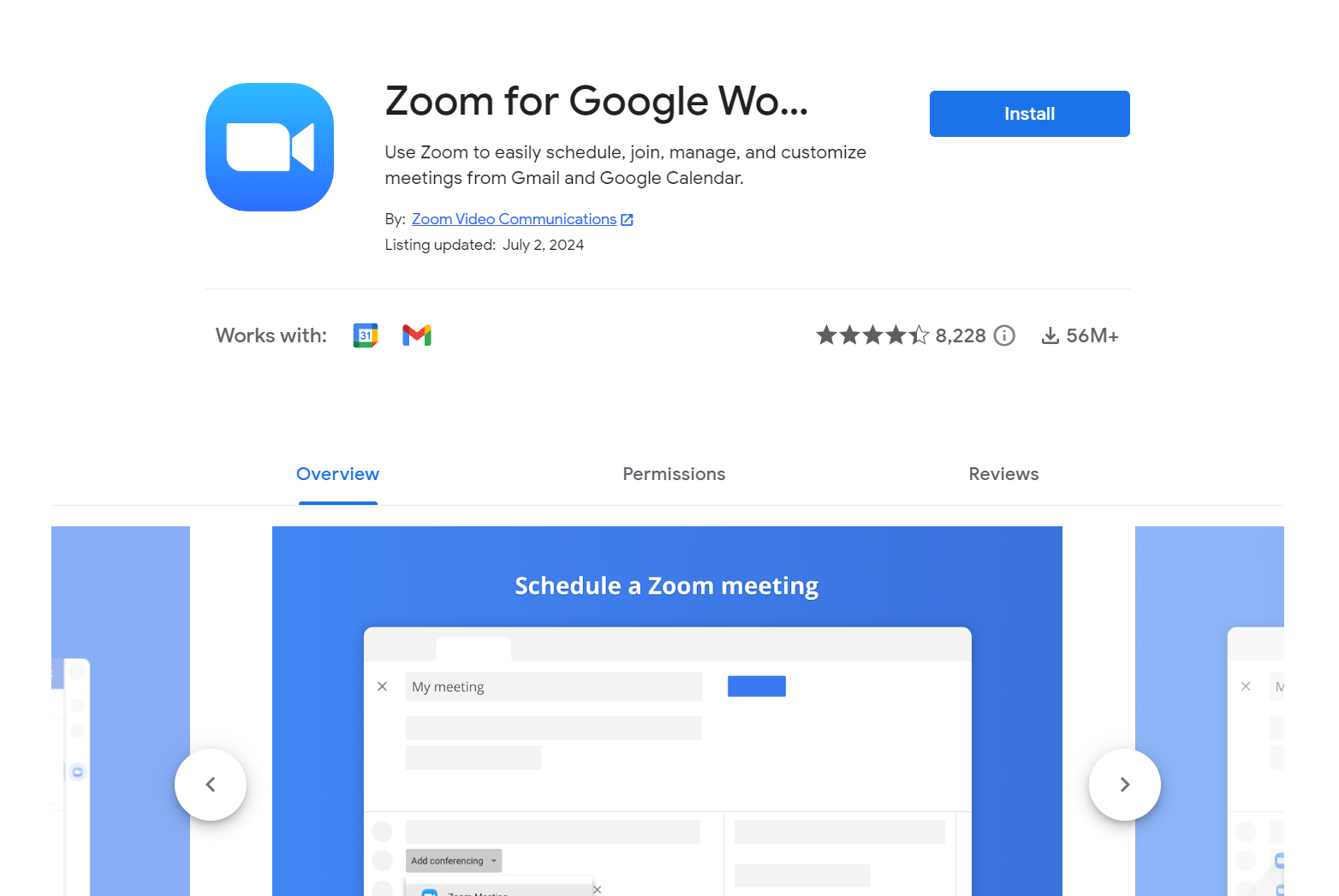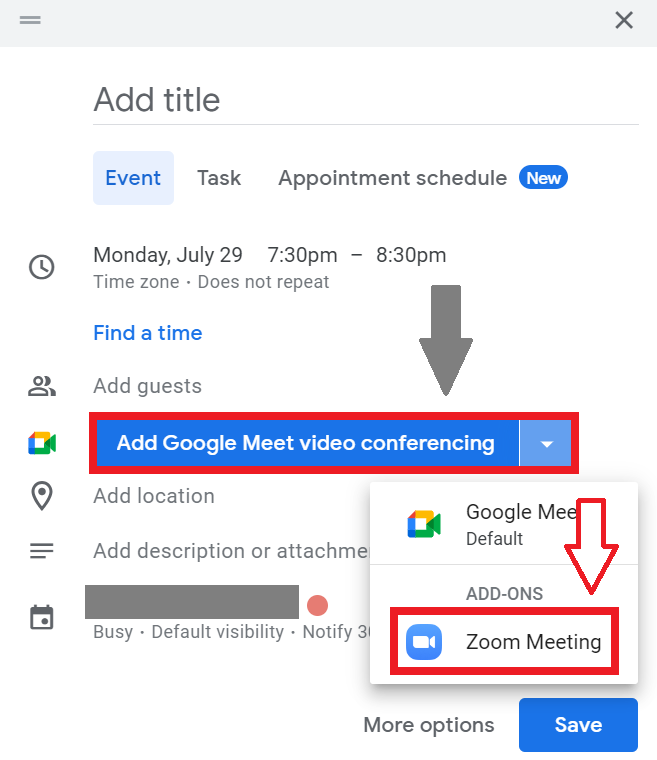Integrate Zoom with Google Calendar Step-by-Step
August 20, 2024
August 20, 2024
June 12, 2025
June 12, 2025
Integrating Zoom with the Google Calendar app can significantly enhance your scheduling efficiency and ensure that your meetings are seamlessly organized. Whether you’re working remotely or managing a busy calendar, this step-by-step guide will walk you through the process, making it easy to schedule, join, and manage Zoom meetings directly from your Google Calendar.
For more tips on mastering Zoom, learn how to set up a Zoom meeting and use Zoom in Browser.
What is Zoom for Google Workspace?
Integrating Zoom with Google Calendar can streamline your scheduling and improve your productivity. With the Zoom for Google Workspace add-on, you can easily schedule and join Zoom meetings directly from your Google Calendar.
The Zoom for Google Workspace add-on is fully compatible with Google Calendar. It works with a personal Google account and a Google Workspace account. You can:
- Schedule one-time or recurring Zoom meetings.
- Automatically sync meeting details with your Google Calendar meeting events.
- Ensure that all scheduled Zoom meetings appear on your Google Calendar, preventing double bookings and missed meetings.
Why Integrate Zoom with Google Calendar?
Integrating Zoom with Google Calendar offers numerous advantages that can revolutionize the way you manage your time and meetings. Here are the key reasons to consider this integration:
Streamline Scheduling and Meeting Management
- Effortless Scheduling: Adding Zoom meeting links directly within the Google Calendar app makes it easy to schedule meetings with one click. No need to jump between apps or copy-paste links.
- Unified Platform: Manage all your meeting details in one place. When you create or update a meeting in Google Calendar, Zoom meeting details are automatically included and synced.
Enhance Productivity and Collaboration
- Centralized Information: Having all meeting details, including the Zoom meeting link, in your Google Calendar allows you and your team to access everything you need without extra steps.
- Quick Setup: You can set up meetings quickly and efficiently, which leaves more time for productive work. Use the time saved for important tasks rather than administrative activities.
Automated Meeting Reminders and Updates
- Automatic Notifications: Google Calendar sends reminders for your Zoom meetings, ensuring you never miss an important meeting. These reminders can pop up on your desktop or mobile device.
- Real-Time Updates: Any changes to the meeting details are automatically updated for all participants, reducing confusion and ensuring everyone is on the same page.
Integration Benefits for Remote Teams
- Improved Communication: Remote teams benefit significantly from integrating Zoom with Google Calendar. It ensures that all team members, regardless of location, have access to the same meeting details.
Incorporating these features into your workflow can greatly enhance efficiency and collaboration, making the integration of Zoom with Google Calendar a valuable tool for any team.
How to Install Zoom for Google Workspace Add-On
Integrating Zoom with Google Calendar starts with installing the Zoom for Google Workspace add-on. This guide will walk you through the entire process, from installation to troubleshooting common issues.
Step-by-Step Installation Guide
- Open Google Workspace Marketplace: Visit the Google Workspace Marketplace in your browser.
- Search for Zoom: Type "Zoom for Google Workspace" in the search bar and select the add-on from the results.
- Click Install: Press the "Install" button and follow the on-screen instructions to add Zoom to your Google Workspace.

- Approve Permissions: Google will request access permissions. Click "Allow" to grant the necessary permissions.
- Sign in to Zoom: After installation, sign in to your Zoom account to complete the setup.
Permissions and Access Requirements
- Calendar Access: The add-on requires access to your Google Calendar to add and manage Zoom meeting links.
- Email Permissions: Allowing email access ensures meeting invitations and updates are sent automatically.
- User Data: Granting permission to user data helps synchronize your Zoom and Google accounts seamlessly.
Troubleshooting Common Installation Issues
Multiple Google Accounts:
- Issue: Problems often arise if you're signed into multiple Google accounts.
- Solution: Sign out of all accounts, then sign back into the one you wish to integrate with Zoom.
Authorization Errors:
- Issue: Sometimes, you might face authorization issues during installation.
- Solution: Ensure you grant all required permissions. If the issue persists, clear your browser cache and cookies, then try again.
Add-On Not Appearing:
- Issue: The Zoom add-on may not show up in Google Calendar.
- Solution: Refresh your browser. If it still doesn’t appear, check the right sidebar and click the arrow to expand it.
Following these steps and tips will ensure a smooth Google Calendar-Zoom integration, allowing you to streamline your scheduling and improve your productivity.
How to Add Zoom Meetings to Google Calendar
Using Zoom for Google Workspace
Scheduling a Zoom Meeting Through Google Calendar:
- Open Google Calendar: Navigate to Google Calendar on your browser.
- Create a New Google Calendar Event: Click on the date and time you wish to schedule a meeting and select "More Options."
- Add Conferencing: In the Google Calendar event details, click the "Add Google Meet Conferencing" dropdown and choose "Zoom Meeting."

- Sign In: If prompted, sign into your Zoom account to link it.
- Save Event: Fill in the event details, such as the meeting title and participants, then click "Save."
Adding A Zoom Meeting Link to Events:
- Automatic Addition: When you select "Zoom Meeting" as the conferencing option, the Zoom meeting link is automatically added to the event.
- Manual Addition for Existing Events: Open the event, click "Edit," then add the Zoom meeting link manually if previously not included.
Customizing Meeting Settings and Options:
- Open Zoom Settings: Click on the Zoom icon in the event details.
- Adjust Settings: Customize settings like waiting rooms, participant video, and meeting passwords.
- Save Changes: After making adjustments, ensure you save the event again to apply changes.
Manually Adding Zoom Links
Creating Zoom Meetings on the Zoom Portal:
- Sign In to Zoom: Sign into your Zoom account.
- Schedule a Meeting: Click "Schedule a Meeting" and fill in the necessary details such as topic, date, and time.
- Save: Once all details are entered, click "Save" to generate the meeting link.
Copying and Pasting Zoom Links into Google Calendar Events:
- Copy the Link: After scheduling the meeting on the Zoom portal, copy the generated meeting link.
- Open Google Calendar: Create a new Google Calendar event or edit an existing one.
- Paste the Link: In the event details, paste the Zoom meeting link into the "Description" or "Location" field.
- Save Event: Ensure you save the event to update all participants with the Zoom link.
Adding Zoom meetings to Google Calendar, whether through the integrated add-on or manually, helps keep your meetings organized and accessible. By following these steps, you ensure all participants have the necessary information to join the meeting without hassle.
How to Make Zoom the Default Video Service in Google Calendar
Navigating to Google Calendar Settings:
- Open Google Calendar: Begin by opening Google Calendar in your web browser.
- Access Settings: Click on the gear icon at the top right corner of the screen and select "Settings" from the dropdown menu.
- Find Event Settings: In the left-hand sidebar, scroll down and click on "Event settings."
Selecting Zoom as the Default Video Conferencing Service:
- Default Video Option: In the "Event settings" section, locate the "Default video conferencing" option.
- Choose Zoom: Click on the dropdown menu next to "Default video conferencing" and select "Zoom Meeting" from the list of available options.
- Save Changes: Scroll to the bottom of the settings page and click "Save" to apply the changes.
Managing Multiple Video Conferencing Options:
- Check Existing Integrations: Navigate back to the settings menu and click on "Add-ons" to see all integrated video conferencing tools.
- Disable Unused Services: If other video conferencing services are enabled that you don’t plan to use, disable them to avoid confusion.
- Prioritize Zoom: Ensure Zoom is set as the priority service by reordering the add-ons if the interface allows it.
Ensuring All Team Members Use the Default Setup:
- Communicate Changes: Inform your team about the new default video conferencing setup. An email or a quick meeting can help everyone get on the same page.
- Team Training: Offer a brief training session or share a tutorial on how to set Zoom as their default on their personal settings.
- Admin Settings: If you’re a Google Workspace administrator, you can enforce the default settings across all users. Go to the admin console, navigate to "Apps," select "Google Workspace," then "Calendar," and finally set Zoom as the default video conferencing service for all users.
Setting Zoom as the default video service in Google Calendar simplifies meeting scheduling and ensures consistency across your organization. This approach minimizes the risk of confusion and enhances productivity by streamlining the process for everyone involved.
{{rt_cta_ai-convenience}}
Enhancing Your Zoom Meetings with Tactiq

What is Tactiq?
Tactiq is a robust tool designed to elevate your Zoom meetings by offering live transcriptions, AI-generated summaries, and innovative features like AI meeting kits and prompts. Here’s how Tactiq can enhance your Zoom experience:
- Live Zoom Transcriptions & AI Summaries: Tactiq provides real-time transcriptions during your Zoom meetings, capturing every detail. After the meeting, AI-driven meeting summaries highlight key points, making it easy to review discussions without watching the entire recording.
- AI Meeting Kits & Prompts: Tactiq’s AI meeting kits and customizable prompts help streamline follow-up tasks, such as drafting emails or creating Jira tickets, directly from your meeting notes.
- Automated Post-Meeting Actions: With Tactiq, follow-up actions like assigning tasks or sending summaries are automated, reducing manual work and ensuring nothing is overlooked.
- Seamless Zoom Integration: Tactiq integrates seamlessly with Zoom, allowing you to focus on the conversation while it handles note-taking, summarizing, and action item tracking.
By leveraging Tactiq’s powerful features, you can transform your Zoom meetings into efficient, well-documented, and productive sessions, saving time and improving team collaboration.
Integrating Zoom with Google Calendar lets you schedule and join meetings directly from your calendar, so you avoid switching between apps or copying links. This streamlines your scheduling, reduces double bookings, and ensures you never miss a meeting, saving you time and boosting productivity.
To install the Zoom add-on, visit the Google Workspace Marketplace, search for 'Zoom for Google Workspace,' click 'Install,' approve the requested permissions, and sign in to your Zoom account. Completing these steps ensures Zoom is fully integrated with your Google Calendar for seamless meeting management.
You can add a Zoom link by selecting 'Zoom Meeting' as the conferencing option when creating a new event in Google Calendar, which automatically inserts the link. For existing events, simply edit the event and paste the Zoom link into the description or location field, ensuring all participants have easy access.
If the Zoom add-on doesn’t appear, refresh your browser and check the right sidebar in Google Calendar. For installation issues, sign out of multiple Google accounts, grant all required permissions, and clear your browser cache and cookies to resolve common problems quickly.
Tactiq provides live transcriptions, AI-generated summaries, and automated follow-up actions for your Zoom meetings, so you capture every detail without manual note-taking. This means you can focus on the conversation, easily review key points, and ensure action items are tracked and completed, making your meetings more productive.
Want the convenience of AI summaries?
Try Tactiq for your upcoming meeting.
Want the convenience of AI summaries?
Try Tactiq for your upcoming meeting.
Want the convenience of AI summaries?
Try Tactiq for your upcoming meeting.









